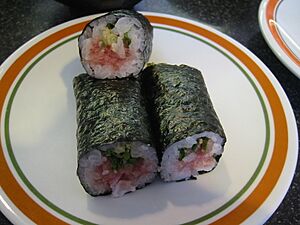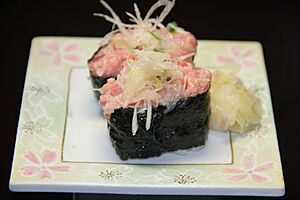Negitoro facts for kids


Negitoro (Japanese: ネギトロ) is a popular Japanese cuisine dish. It's made from finely chopped raw tuna. This usually comes from the fatty parts of the fish that are scraped off the bones. Negitoro is often served with green onion.
You can find Negitoro in different types of sushi. It's also a common topping for rice bowls, creating a dish called Negitorodon. It's a tasty and unique way to enjoy tuna!
Contents
Where Does the Name Negitoro Come From?
There are a few ideas about how Negitoro got its name.
Green Onion and Fatty Tuna
One popular idea is that the name "Negitoro" comes from two words:
- Negi (Japanese: ネギ), which means green onion.
- Toro (Japanese: トロ), which refers to the fatty, delicious parts of tuna.
Since the 1980s, people have loved combining fatty tuna with strong-flavored vegetables. The mix of toro, green onion, and nori seaweed has become very popular because they taste so good together.
Another Idea for "Toro"
Some people think the "toro" part of the name might not refer to tuna fat. One restaurant, which might have invented the dish, suggests it was named after a different popular dish called mugitoro. This dish was well-known in the area at the time.
How Negitoro is Made for Stores
Negitoro that you buy in supermarkets is often made in factories. These factories make large amounts of it. They use different kinds of fish, not just tuna. This can include yellowfin tuna, marlin, bigeye tuna, and albacore.
To make the texture and taste just right, they might add other ingredients. These can include vegetable oil, shortening, lard, and special ingredients to keep it fresh.
Some groups in Japan have wondered if this way of making Negitoro is clear enough for shoppers. They also think about if it's the healthiest option. However, some also say that tuna scrape that isn't processed much isn't as popular with people.

